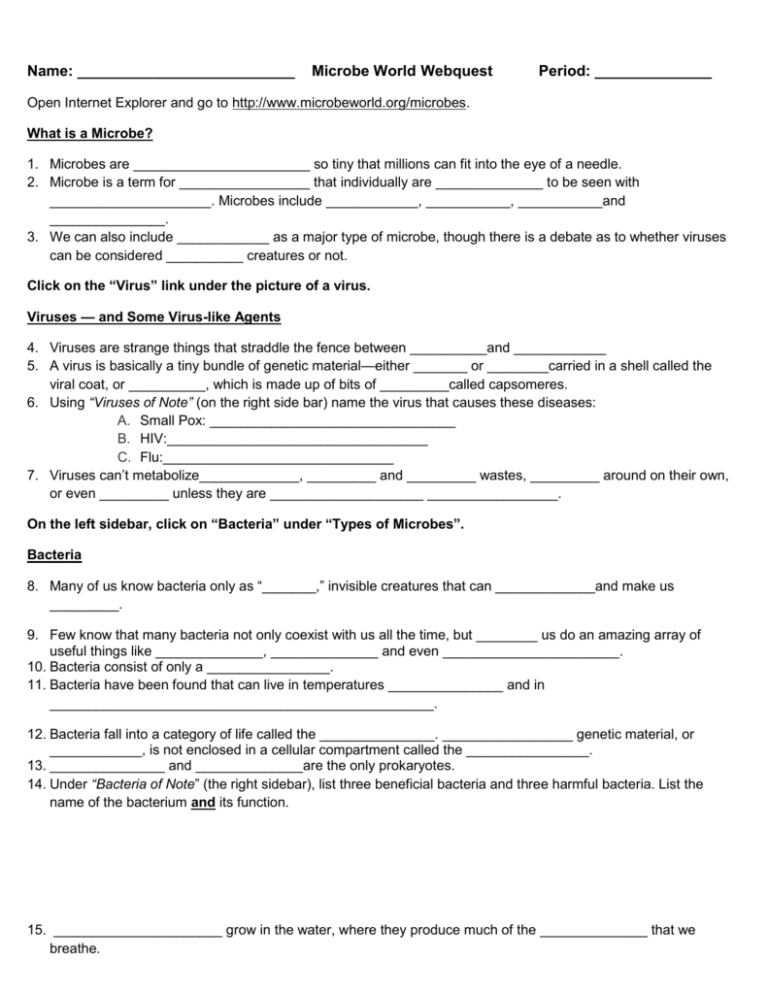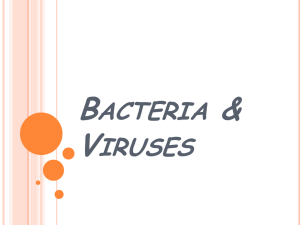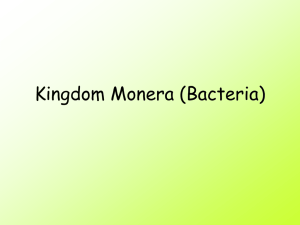Name: Microbe World Webquest Period: Open Internet Explorer and
advertisement

Name: __________________________ Microbe World Webquest Period: ______________ Open Internet Explorer and go to http://www.microbeworld.org/microbes. What is a Microbe? 1. Microbes are _______________________ so tiny that millions can fit into the eye of a needle. 2. Microbe is a term for _________________ that individually are ______________ to be seen with _____________________. Microbes include ____________, ___________, ___________and _______________. 3. We can also include ____________ as a major type of microbe, though there is a debate as to whether viruses can be considered __________ creatures or not. Click on the “Virus” link under the picture of a virus. Viruses — and Some Virus-like Agents 4. Viruses are strange things that straddle the fence between __________and ____________ 5. A virus is basically a tiny bundle of genetic material—either _______ or ________carried in a shell called the viral coat, or __________, which is made up of bits of _________called capsomeres. 6. Using “Viruses of Note” (on the right side bar) name the virus that causes these diseases: A. Small Pox: ________________________________ B. HIV:__________________________________ C. Flu:______________________________ 7. Viruses can’t metabolize_____________, _________ and _________ wastes, _________ around on their own, or even _________ unless they are ____________________ _________________. On the left sidebar, click on “Bacteria” under “Types of Microbes”. Bacteria 8. Many of us know bacteria only as “_______,” invisible creatures that can _____________and make us _________. 9. Few know that many bacteria not only coexist with us all the time, but ________ us do an amazing array of useful things like ______________, ______________ and even _______________________. 10. Bacteria consist of only a ________________. 11. Bacteria have been found that can live in temperatures _______________ and in __________________________________________________. 12. Bacteria fall into a category of life called the _______________. _________________ genetic material, or ____________, is not enclosed in a cellular compartment called the ________________. 13. _______________ and ______________are the only prokaryotes. 14. Under “Bacteria of Note” (the right sidebar), list three beneficial bacteria and three harmful bacteria. List the name of the bacterium and its function. 15. ______________________ grow in the water, where they produce much of the ______________ that we breathe. Click on “What They Look Like” under “Bacteria” on the left side bar. What They Look Like 16. There are ___________ of species of bacteria, but all of them are basically one of __________ different shapes. Some are _________or _____-shaped and called ________________. Others are shaped like little balls and called ____________. Others still are __________ or ___________ in shape, like the Borrelia pictured at the top of this page. 17. Some bacteria do have natural colors. Certain species contain ____________, such as various _____________, that make them naturally _________, __________, ___________, or ________. Colonies of ___________ of bacteria may appear pink, yellowish, or white. Click on “Where They are Found” under “Bacteria” on the left side bar. Where They’re Found 18. Bacteria can be found virtually everywhere. They are in the _________, the _____________, and __________, and in and on ___________ and ____________, including ________. 19. The human mouth is home to more than ________ species of bacteria. 20. Some bacteria (along with archaea) _____________ in the most forbidding, uninviting places on Earth, from ____________________ to __________________________ buried under ________________________. 21. Microbes that dwell in these extreme habitats are aptly called ___________________. Click on “How They Move” under “Bacteria” on the left side bar. How They Move 22. Some bacteria have hair- or whip-like appendages called ____________ used to ‘swim’ around. Others produce thick coats of __________ and ‘glide’ about. Some stick out thin, rigid spikes called ____________ to help hold them to surfaces. Click on “Virus Or Bacterium?” on the left side bar. Virus Or Bacterium? 23. Using this page, name three differences and one similarity between viruses and bacteria. Differences in Bacteria 1. 2. 3. Similarities Differences in Viruses 1. 2. 3. 24. Why are viruses called “moochers”? 25. Draw and label a picture of a bacterium and a virus. Bacterium Virus Click on “Discovery Timeline” on the left side bar. Discovery Timeline Using the Discovery Timeline, write a description of the contributions of these scientists. Include the year, what they discovered and any experiments they conducted. Note: Scientists may appear more than once on the timeline. You will have to click on the different time periods to find them all. 26. Robert Koch: 27. Alexander Fleming: 28. Francis Crick and Maurice Wilkins, together with James Watson: 29. Paul Ehrilch: 30. Francis Peyton Rous: Click on “Tools and Techniques” on left side bar. Then click on “Microscopes”. Microscopes 31. The invention of the first true microscope is credited to the ___________ family of Middleburg, Holland, around _________. 32. Later, in the 17th century, Dutch cloth merchant and amateur scientist __________________________ enlightened the world to what he dubbed “___________” such as ___________ found in standing water. Using _____________ he made himself________________ wrote up what he viewed in __________, ___________________, even ______________________________________ 33. There are two basic types of microscopes: __________ microscopes and ____________microscopes. 34. Light microscopes can magnify an object up to __________ times. 35. _______________ microscopes use streams of ___________ instead of light to create images. 36. There are three types of electron microscopes: _________________________, _____________________________ and _______________________________. 37. Which two of these are especially useful when viewing cells? Why? 36. Which of these can “see” individual atoms on an object’s surface? Under “Did You Know” at the top of the page, click on “Everyday Roles” Everyday Roles 37. Click on the different pictures and read about the good things that bacteria do. List five “good bacteria” and what role they perform. Click on “World Record For”, then go to “Deadliest, Scariest of All” Give a brief description of the deadliest and scariest pathogens.









